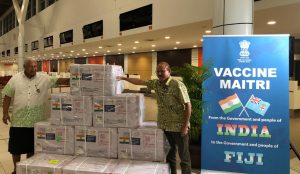After a break of almost six months, India has announced that it intends to resume exporting COVID-19 vaccines once more, starting this month. Significantly, the announcement came shortly before Prime Minister Narendra Modi left for Washington to attend a Quad leaders’ summit.
Early this year, as scientists found breakthroughs in the search for a vaccine, India saw a unique strategic opportunity to play the role of the world’s pharmacy. With its highly advanced pharmaceutical industry and as a leading vaccine manufacturer, Modi said that India is “ready to save humanity.” Notably, more than half of India’s vaccine supplies to countries in the neighborhood – Bangladesh, Myanmar, Nepal, Bhutan, Maldives, Sri Lanka and Afghanistan – were delivered through commercial deals and not grants.
But as a devastating second wave of COVID-19 swept across India, vaccine diplomacy went bust. India suspended its vaccine exports in mid-April after having delivered 66 million doses to various developing countries, especially in the neighborhood.
In India’s absence, China filled the vacuum. With few other options available, many South Asian countries began importing millions of doses from Beijing. By the end of September, China had already delivered over 140 million doses across South Asia, including Myanmar and Afghanistan. Pakistan, Bangladesh and Sri Lanka are among the top 10 recipients of Chinese vaccine exports worldwide.
Yet, despite the lost opportunity earlier in the year, India will find that many of its neighbors will be only too happy to see New Delhi competing with China in this space again.
For some countries, the monopoly of vaccine supply by China has meant the threat of Chinese political influence in strategic affairs. In May, as China had just begun filling up India’s vacuum, the Chinese ambassador to Bangladesh warned Dhaka that joining the Quad will “substantially damage” its relations with China. Later, a controversy blew up in Sri Lanka over the cost of China’s vaccines, after reports suggested that the Sri Lankan government had procured each of its doses at $5 higher than Bangladesh.
Questions have also been raised over the efficacy of China’s COVID-19 vaccines more generally, and many countries have begun to move away to other alternatives. In July, Thailand and Indonesia announced that they were transitioning to AstraZeneca and Moderna vaccines as booster shots (AstraZeneca vaccines are also manufactured by the Serum Institute of India – India’s largest vaccine manufacturer). A few other countries followed suit, and from July to August this year, China’s vaccine exports fell by 21 percent.
Many parts of South Asia will now be hoping that India can step up, especially given the low rates of vaccination across the region. While 46 percent of the Indian population and almost 68 percent of Sri Lankans have now received at least one dose, this figure is much lower elsewhere: 24 percent in Nepal, 19 percent in Bangladesh and a paltry 13 percent each in Myanmar and Pakistan.
Yet, much of New Delhi’s vaccine diplomacy potential would depend on India’s own vaccination rate – which is as yet extremely slow. While the Modi government had promised to vaccinate all Indians by the end of the year, less than 17 percent have been fully vaccinated so far, and experts believe that India will need to administer more than 10 million doses a day to achieve its target. That would translate to a whopping 300 million doses a month – far beyond what India has been able to produce so far.
India will have to seek a balance between its domestic vaccination and its export of vaccines. The more that India delays its exports, the more likely it will be to lose goodwill. But that risk will also apply – perhaps much more seriously – if India promises vaccine doses to its neighbors and then reneges for want of supply at home.
Like most countries that are stuck between two relatively large neighbors anywhere in the world, most South Asian countries would prefer a healthy balance of power between India and China, as opposed to a monopoly of power by either country. India will find its return to vaccine diplomacy widely welcomed by its neighbors.
Meanwhile, India’s allies in the Quad too will be pleased. In March this year, the Quad had pledged to boost India’s vaccine manufacturing capacity in order to provide 1 billion doses to Southeast Asian countries. That promise was reiterated during Modi’s trip to Washington a few days ago. The world will now hope that India can step up.

































